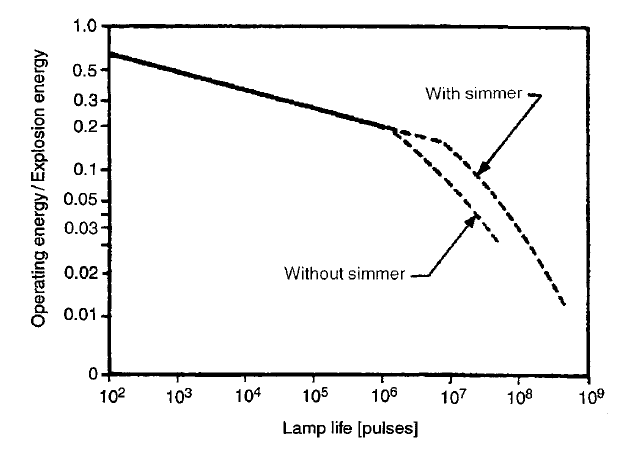
Flashtube Explosion
 المؤلف:
Walter Koechner Michael Bass
المؤلف:
Walter Koechner Michael Bass
 المصدر:
Solid-state Lasers
المصدر:
Solid-state Lasers
 الجزء والصفحة:
192
الجزء والصفحة:
192
 2-2-2021
2-2-2021
 2620
2620
Flashtube Explosion
When a high-voltage trigger pulse is applied between the electrodes of a flashtube, the gas breaks down generally near the axis of the tube and a conducting filament is established. As energy is released into the channel, heating of the ambient gas causes the filament to expand radially, forming cylindrical shock waves.
The shock front and its associated plasma travel radially from the tube axis to its wall. The radial velocity of the plasma discharge and the shock amplitude are proportional to the input energy. The cylindrical shock wave and the associated plasma heat cause stress on the inside of the tube wall, which is axial in tension toward the electrodes. If the energy discharged exceeds the explosion limit for the lamp, the shock wave will be sufficiently intense to rupture the lamp walls and consequently destroy the lamp.
The explosion energy is directly related to the inside-wall surface area of the lamp and to the square root of the pulse duration. If l and D are measured in centimeters and tp is in seconds, and if a critically damped single-mesh discharge circuit is assumed, then it has been found empirically that for xenon-filled quartz flashtubes the explosion energy in Joules is
 ..........(1)
..........(1)
Having determined the ultimate limit for the tube, the question of the life that the tube will have in a given application has to be addressed. It has been shown that lamplife can be related to the fraction of explosion energy at which the lamp is operated. The life in flashes for a xenon-filled quartz-envelope flashlamp as a function of the single-shot explosion energy is empirically given by
 .........(2)
.........(2)
The extremely strong dependence of flashlamp lifetime on the input energy Ein is a great incentive to underrate the lamp.
In Fig. 1 life expectancy as a function of lamp input is shown, assuming that the interpulse interval is sufficiently long to permit the tube to cool between pulses. The lifetime expressed by (2) is defined as the number of shots at which the light output is reduced by 50% of its initial value. The life expectancy of a flashlamp begins to deteriorate rapidly when peak current exceeds 60% of explosion current. Above 60%, the lamp’s life is usually limited to less than 100 discharges, even if all other parameters are optimized. At the 80% level, explosion can occur on any discharge. Most flashlamps, with the exception of lamps installed in single-shot lasers, such as, for example, employed in inertial confinement fusion, are operated at only a small fraction of the explosion energy. In this case, cathode degradation is the primary failure mode. The two dotted lines in Fig. 1 indicate where the cathode end of life begins to occur. As explained below, lamplife is considerably improved by operation in the simmer mode which

FIGURE 1. Lamp life as a function of operating energy.
keeps the lamp continuously ionized at a low-current level. Because of the increased lamplife most lamps are operated in the simmer mode today.
 الاكثر قراءة في مواضيع عامة في الليزر
الاكثر قراءة في مواضيع عامة في الليزر
 اخر الاخبار
اخر الاخبار
اخبار العتبة العباسية المقدسة


